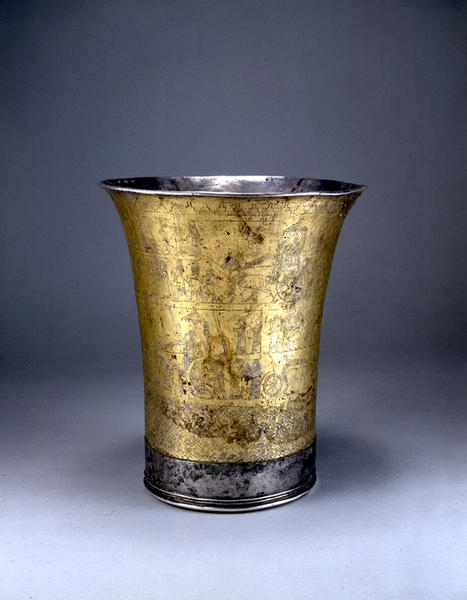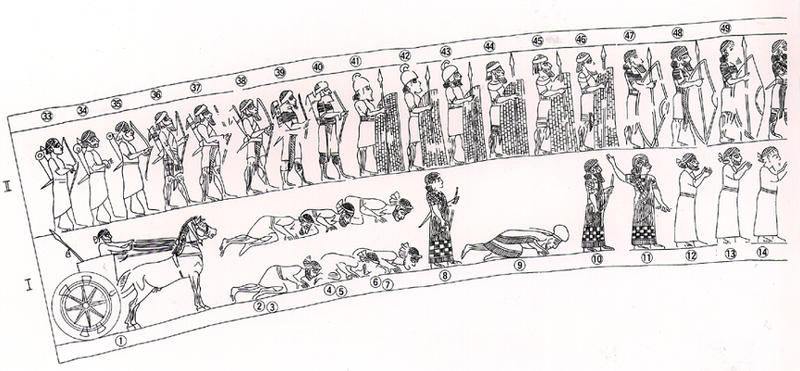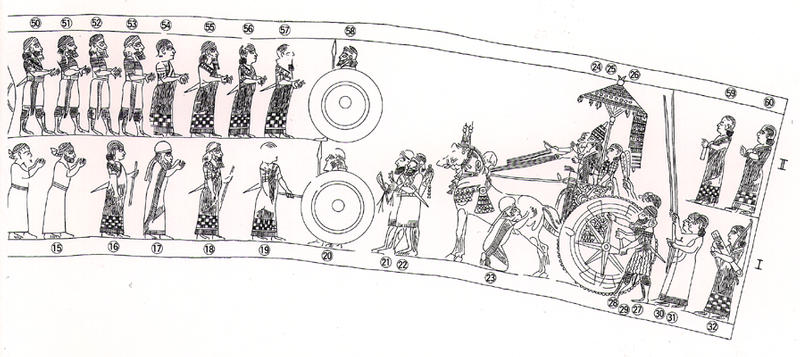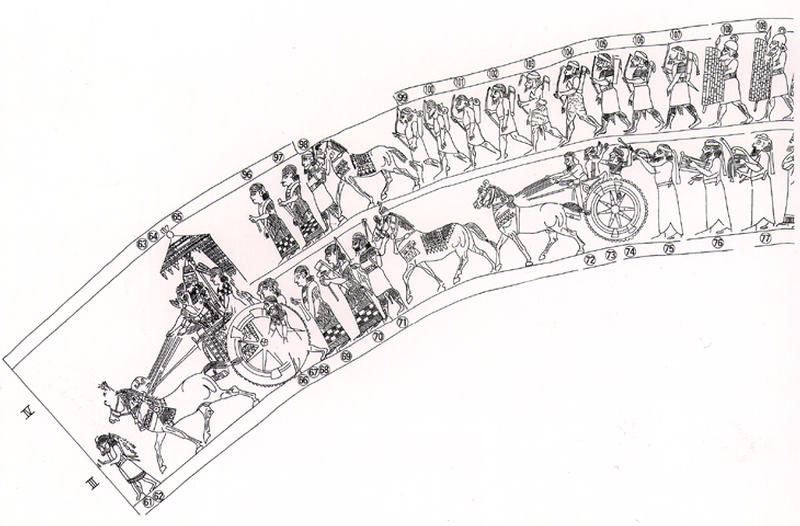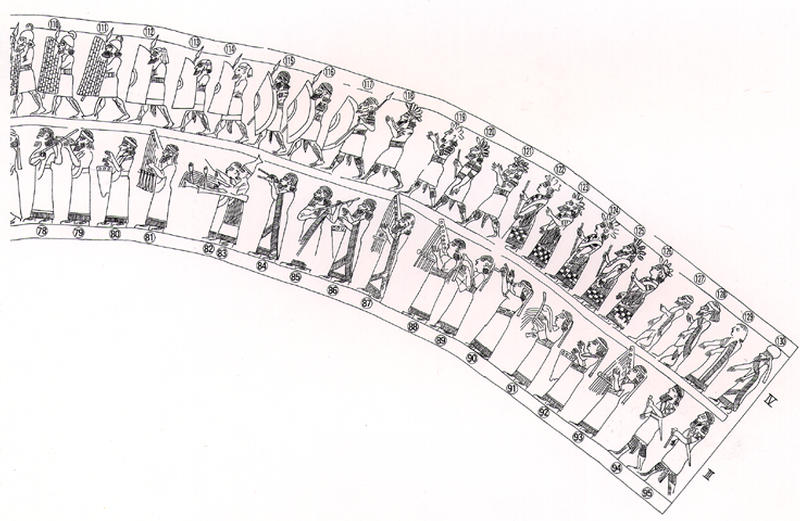戦勝図杯
- イラン西部/アッシリア
- 前7世紀
- 銀、金
- H-24.5 D-21
この銀製鍍金の大杯表面には上下二段に合計130人を数える、アッシリア王率いるアッシリア軍の隊列と楽隊、それらに従うエラムの捕虜及びエラム王の姿が描かれている。気球形の王冠を被ったエラム王ウマン・ハルダシュ三世はアッシリア王アッシュールバニパルの馬車の前で跪き懇願する仕草をしている。この大杯に描かれた場面はエラム王の逮捕と彼の命乞いを描いたものであると理解される。口縁外面にライオンの図雑に続きアッシュールバニパル王名の銘文が刻まれ、器の内縁に新エラム語の楔形文字でイラン系の王名であると思われる文字が刻まれている。一つの器に二つの異なる民族の王の銘文が刻まれるということはそれほど頻繁に起こるものではない。圧倒的な勢力を誇ったこのメソポタミアの帝国とイラン高地の民族との朝貢関係の下賜品として、もしくは抗争の戦利品として、イラン側にもたらされイランの王名を刻まれた可能性は大いにあったと思われる。
下フリーズ(1~60)
l.下フリーズ下列
エラム人のアッシュールバニパルへの屈服。
32人(1ー32)
1 馬車に乗るエラム人御者
2ー7 アッシリア王の前で土下座する6人のエラム人
8 杖を持つ宮臣
9 アッシリア王の前で土下座する気球型冠を被ったエラム王
10 杖を持つ宮臣
11 指示する宮臣
12ー15 懇願する四人のエラム人
16 杖を持つ宮臣
17 懇願する気球型冠を被ったエラム王
18-19 二人の杖を持つ宮臣
20 槍と丸い楯を持った警備兵
21-22 鞭を持った二人の馬丁
23 アッシュールバニパルの前で跪き懇願するエラム王
24 アッシュールバニパルの御者
25 馬車に乗り左手に花を持ち右手を挙げ語る仕草のアッシリア王アッシュールバニパル
26 アッシュールバニパルの日除け持ち
27 アッシュールバニパルの馬車の車輪近くをかためる兵士
28-29 二人の払子を持ったアッシュールバニパルの護衛兵
30-31 二人の長い棒を持った宮臣
32 アッシリア王の武器持ち
ll.下フレーズ上列軍隊行列
28の人物(33-60)
33-35 三人のエラムまたはエリピの弓兵
36-38 三人のシリア弓兵
39-40 二人のバビロニア弓兵
41-43 三人の尖頭形に組んだ楯を持つ北シリア槍兵
44-46 三人の尖頭形に組んだ楯を持つバビロニア槍兵
47-49 三人の湾曲した丸い楯を持つアッシリア本国の槍兵
50-53 四人の武器を持たず胸前に手を組んだアッシリアの将校
54-57 四人の胸前に手を組んだ高位宮臣
58 槍と丸い楯を持った警備兵
59-60 アッシュールバニパルの護衛兵中の宮臣
上フリーズ(61~130)
lll.上フリーズ下列
馬車上の一人の抵抗する男、演奏する楽隊
35の人物(61-95)
61-62 アッシュールバニパルの馬車馬の前を歩む馬丁
63 アッシュールバニパルの御者
64 アッシリア王アッシュールバニパル
65 アッシリア王の日傘持ち
66 車輪近くの兵士
67-68 二人の払子を持った宮臣
69 布を持った宮臣
70 アッシュールバニパルの武器持ち
71 馬を牽く兵士
72 御者
73 護送される、房飾りのついた衣服を纏い頭に幅広の鉢巻きをつけ、腕を上に挙げ後ろに向いている男
74 捕虜を抑え棍棒で威嚇する兵士
75 ダブルフルートを奏する兵士
76 無装飾の竪琴を奏する楽人
77 弓形のアームのついた竪琴の奏者
78 リュート奏者
79 ダブルフルート奏者
80 ティンパニー奏者
81 竪琴を奏する楽人
82-83 首部が人間の手の形をしたハープを演奏する二人
83 魚尾形の頭飾をつけた神官
84 ダブルフルート奏者
85 リュート奏者
86 ティンパニー奏者
87-88 二人の竪琴奏者
89 無装飾のハープ奏者
90 ダブルフルート奏者
91 弓形のアームのついた竪琴奏者
92 ティンパニー奏者
93 竪琴奏者
94-95 二人の棍棒を持った兵士
lV.上フリーズ上列
アッシリア軍の整列行進
花冠をつけた兵士と宮臣の後に続く征服された敵兵あるいは人質。
35の人物(96-130)
96 弓を持った宮臣
97 棍棒を持った宮臣
98 馬を牽く兵士
99-101 三人のエラムもしくはエリビの弓兵
102-104 三人のリビアの弓兵
105-107 三人のバビロニア弓兵
108-111 四人の尖頭型に組んだ楯を持つ北シリアの槍兵
112-114 三人の中高になった金属製尖頭楯を持つ槍兵
115-117 三人の湾曲した円形楯を持つ槍兵
118-121 四人の花冠をつけた非武装の兵士
122-126 花冠をつけ長い衣服を着た五人の宮臣
127 顕著に小さく表現された、房飾を施した衣服を纏った男
128 房飾を施した衣服を纏う男
129 斜め前に両腕を差し出す男
130 気球型冠を被り斜め前に両腕を差し出すエラム王
Frieze below(1-60)
l.Frieze below-bottom register.
Subjugation of the Elamites under Assurbanipal,32 figures(1-32).
1 Elamite chariot driver in his chariot.
2-7 Six Elamites throwing themselves to the ground before the Assyrian king.
8 Courtiers with staves.
9 Elamite king wearing a balloon shaped cap throwing himself to the
ground before the Assyrian king.
10 Courtier with staff.
11 Court official indicating to something.
12-15 Four Elamite beggars.
16 Courtier with staff.
17 Pleading Elamite king wearing a balloon shaped cap.
18-19 Two courtiers with staves.
20 Guard with a spear/lance and a round shield.
21-22 Two ostlers with whips.
23 Elamite king kneeling plesdingly in front of Assurbanipal.
24 Chariot driver of Assurbanipal.
25 Assurbanipal,king of Assyria,in his chariot lifting his right arm
as if to speak while holding a blossom in his left.
26 Parasol bearer of Assurbanipal.
27 Soldier beside the wheel of Assurbanipal.
28-29 Two bodyguards of Assurbanipal with fly swatters.
30-31 Two countiers with long staves.
32 Weapon holders of the Assyrian king.
ll.Frieze below-upper register.
Military parade,28 figures(33-60).
33-35 Three archers from Elam or Ellipi.
36-38 Three archers from Syria,mercenaries in the Assyrian army.
39-40 Two archers from Babylon.
41-43 Three spear fighters with woven tower shieds from Babylon.
44-46 Three spear fighters with tower shields having a woven design from Babylon.
47-49 Three spear fighters with convex round shieds from central Assyria
50-53 Four Assyrian officers without weapons;each one has his hands cla-
sped.
54-57 Four high ranking courtiers with hands clasped.
58 Guard with a spear and a round shield.
59-60 Courtiers belonging to the bodyguard of Assurbanipal.
Frieze above(61-130)
lll.Frieze above-lower register.
Abduction of a man by chariot and musicians playing,35 figures(61-95).
61-62 Ostlers in front of the chariot horses of Assurbanipal.
63 Assurbanipal's chariot driver.
64 Assurbanipal,king of Assyria.
65 Parasol bearer of the king of Assyria.
66 Soldier besides a chariot wheel.
67-68 Two courtiers with fly swatters.
69 Courtier with cloth.
70 Weapon bearer of Assurbanipal.
71 Soldier leading a horse.
72 Chariot driver.
73 Man wearing a frayed loose garment and a broad hairband being carried away and turning with raised arms.
74 Soldier restraining the prisoner and threatening him with a club-stick.
75 Musician playing the double-flute.
76 Musician playing an undecorated mobile lyre.
77 Player of the lyre with curved yokearms.
78 Lute player.
79 Musician playing the double-flute.
lV.Frieze above-top register.
Deployment of the Assyrian army,soldiers with wreaths and courtiers followed by defeated enemies and hostages,35 figures(96-130).
96 Courtier with cloth.
97 Courtier with club-stick.
98 Soldier leading a horse.
99-101 Three archers from Elam of Ellipi.
102-104 Three archers from Syria.
105-107 Three archers from babylon.
108-111 Four spear wielding soldiers with woven tower shields from northen Syria.
112-114 Three spear wielding soldiers with metal tower shields that have
face centered circular impressions.
115-117 Three spear wielding soldiers with convex round shields.
118-121 Four soldiers without weapons,wearing wreaths.
122-126 Five courtiers in long garments,wearing wreaths.
127 Clearly smaller presented man in a frayed toga.
128 Man in a frayed toga.
129 Man extending his arms outwards.
130 Elamite king wearing a balloon shaped cap extending his arms
outwards.
戦勝図杯
極めて簡素な形状の大杯だが、前7世紀に西アジアでくり広げられた、つわものたちの興亡が刻まれている。エジプト、北イランを制圧し残る南イランのエラムをついに支配下に置いたアッシリア。王の戦車の足許にはエラム王が跪く。その王アッシュールバニパルは正にオリエントの王となったのだ。外側の銘文も“世界の王”を宣言している。
しかし“奢る者は久しからず”、話はこれでは終わらない。この器は多くの修繕があり、穴を塞いだ時にこの銘文の一部が隠された。更に器の内側にイラン系の別の王名が刻まれているのだ。前612年栄華を極めたアッシリアの都ニネヴェ陥落。その時この器も戦利品となったのか。この器はアッシリアの絶頂とその後のイラン民族の台頭を暗示している。
King Assurbanirpa's Beaker
The engravings on this very simply-shaped large cup depict the ups and downs of those who traversed Western Asia in seventh-century BC. Assyria subjugated Egypt and Northern Iran, and eventually dominated the Elamites in Southern Iran. The Elamite king kneels at the foot of the Assyrian king's chariot. He, King Assurbanirpal of Assyria, had indeed become the "King of the Orient." The letters on the outside of the cup proclaim him "King of the World."
However, just as "pride comes before a fall," the story did not end there. This vessel has been extensively restored, and a part of the inscription was hidden when filling in holes. What is more, the name of a different, Iranian king has been incised into interior. In 612 BC, the Assyrian capital of Nineveh, which had once enjoyed the height of its glory, fell. This beaker may have been one of the spoils of war at that time; it attests to the great flowering of Assyria and the subsequent rise of Iranian peoples.
